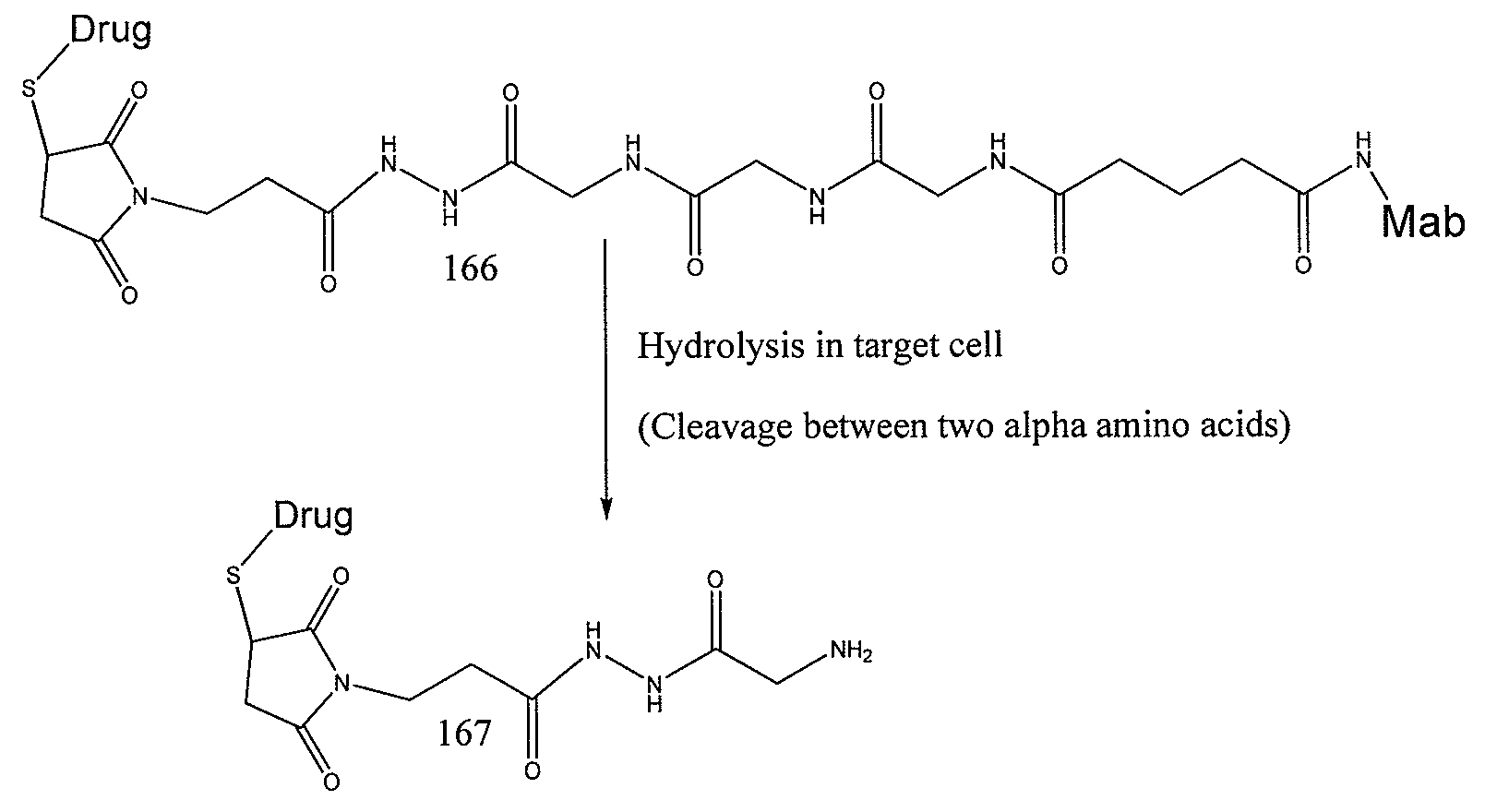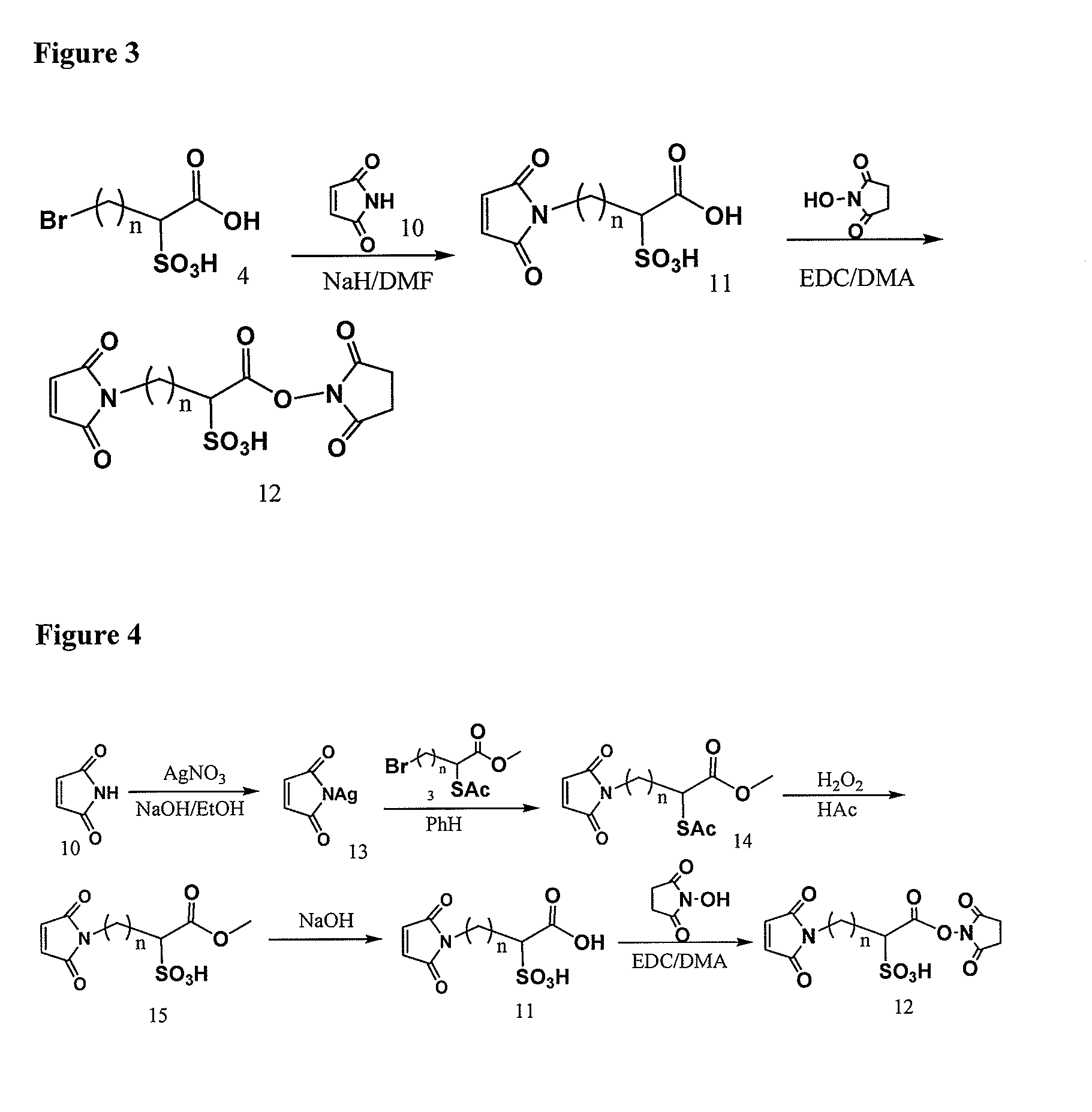Cross-linkers and their uses
- Summary
- Abstract
- Description
- Claims
- Application Information
AI Technical Summary
Benefits of technology
Problems solved by technology
Method used
Image
Examples
example 1
Materials and Methods
Methyl 2-(acetylthio)-4-bromobutanoate
[0283]
[0284]10.0 g (38.4 mmol) of methyl 2,4-dibromobutanoate in 100 ml of dry THF at 20° C. was added drop wise the mixture of 2.75 ml (38.5 mmol) of thiolacetic acid in 8.5 ml (48.9 mmol) of DIPEA and 50 ml of dry THF in 1.5 hour. After stirring overnight at −20° C. then 0° C. for 2 hours under Ar, the mixture was concentrated, diluted with EtAc / Hexane, washed with 1.0 M NaH2PO4, dried over MgSO4, filtered, evaporated, and SiO2 chromatographic purification (1:12 to 1:10 EtAc / Hexane) to afford 9.5 g (96%) of the title compound. 1H NMR (CDCl3) 4.38 (1H, t, J=7.1 Hz), 3.74 (s, 3H), 3.40 (m, 2H), 2.57˜2.47 (m, 1H), 2.37 (s, 3H), 2.36˜2.21 (m, 1H); 13C NMR 193.24, 171.36, 53.15, 44.45, 34.67, 30.46, 29.46; MS m / z+276.9 (M+Na), 278.9 (M+2+Na)
4-Bromo-1-methoxy-1-oxobutane-2-sulfonic acid
[0285]
[0286]9.2 g (36.3 mmol) of methyl 2-(acetylthio)-4-bromobutanoate in 80 ml of acetic acid was added 40 ml of hydrogen peroxide (35% in wate...
example 2
Conjugate Synthesis
[0362]SPP or SSNPP linker was dissolved in ethanol at a concentration of approximately 10 mM. Antibody was dialyzed into buffer A (50 mM KPi, 50 mM NaCl, 2 mM EDTA, pH 6.5). For the linker reaction, the antibody was at 8 mg / ml, and 7 equivalents of linker were added while stirring in the presence of 5% (v / v) ethanol. The reaction was allowed to proceed at ambient temperature for 90 minutes. Unreacted linker was removed from the antibody by Sephadex G25 gel filtration using a Sephadex G25 column equilibrated with Buffer A at pH 6.5 or 150 mM potassium phosphate buffer containing 100 mM NaCl, pH 7.4 as indicated. For the SPP linker, the extent of modification was assessed by release of pyridine-2-thione using 50 mM DTT and measuring the absorbance at 343 nm as described below (ε343=8080 M−1 cm−1 for free pyridine-2-thione). For SSNPP, modification was assessed directly by measuring the absorbance at 325 nm (ε325=10,964 M−1 cm−1 for the 4-nitropyridyl-2-dithio group ...
example 3
In Vitro Cytotoxicity Evaluation of Maytansinoid Conjugates of Antibodies with Thioether (Non-Cleavable) and Disulfide Linkers Containing Sulfonate Group
[0372]The cytotoxic effects of the antibody-maytansinoid conjugates with thioether and disulfide linkers containing a sulfonate group were typically evaluated using a WST-8 cell-viability assay after a 4-5 day continuous incubation of the cancer cells with the conjugates. The antigen-expressing cancer cells (˜1000-5000 cells per well) were incubated in 96-well plates in regular growth medium containing fetal bovine serum with various concentrations of the antibody-maytansinoid conjugates for about 5 days. The WST-8 reagent was then added and the plate absorbance was measured at 450 nm after ˜2-5 h. The survival fraction was plotted versus conjugate concentration to determine the IC50 value (50% cell killing concentration) of the conjugate.
[0373]FIGS. 60 and 61 show the enhancement in cytotoxicities of Anti-CanAg (huC242)-maytansinoi...
PUM
| Property | Measurement | Unit |
|---|---|---|
| Molar density | aaaaa | aaaaa |
| Molar density | aaaaa | aaaaa |
| Molar density | aaaaa | aaaaa |
Abstract
Description
Claims
Application Information
 Login to View More
Login to View More - R&D
- Intellectual Property
- Life Sciences
- Materials
- Tech Scout
- Unparalleled Data Quality
- Higher Quality Content
- 60% Fewer Hallucinations
Browse by: Latest US Patents, China's latest patents, Technical Efficacy Thesaurus, Application Domain, Technology Topic, Popular Technical Reports.
© 2025 PatSnap. All rights reserved.Legal|Privacy policy|Modern Slavery Act Transparency Statement|Sitemap|About US| Contact US: help@patsnap.com



